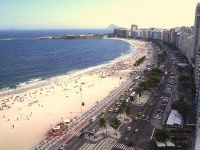 Rio De Janeiro OverviewMention Rio to anyone and immediately the name evokes images of
sultry street parades, the Sugarloaf Mountain cable car, the Christ
the Redeemer statue atop Corcovado mountain, and the 'itsy-bitsy
teeny weeny' bikinis on the beach at Ipanema. The exuberant
cultural capital of Brazil is tucked between the mountains and the
sea and is endowed with awe-inspiring natural beauty. Rio's
beaches, including the famous Ipanema and Copacabana, are a main
attraction due to the city's warm climate. It also contains the
biggest urban forest in the world, the Tijuca Forest, which was
completely replanted during the second half of the 19th
century. The city pulses to the infectious beat of Brazilian music: the
choro, the samba and the bossa nova, and the funk carioca, and is
the cultural capital of Brazil. Its annual carnival, known simply
as Carnaval, draws together the population of the city (known as
the 'Cariocas') ranging from the very rich to the very poor, who
take to the streets for the world's largest samba parade on the
Sambodromo. Rio is a never-ending story made up of 150 districts, each
characterised by unique features like Santa Teresa, a winding maze
of streets populated by artists and musicians, which is reached by
taking an old tram across an ancient aqueduct called Arcos da Lapa.
In the central city area of Rio there are historic monuments and
public buildings like the Municipal Theatre, the National Museum of
Fine Art, the Itamaraty Palace, the National History Museum, and
the National Library. There are also beautiful examples of
religious architecture such as the Sao Bento Monastery. No matter
how long you spend exploring the city, it will always deliver new
surprises. Rio will be overrun with international sporting events in the
next few years, as it is set to be the first South American city to
host the Summer Olympics in 2016, and will be the primary host city
for the FIFA World Cup Soccer Tournament in 2014. To the north of the city is the Lakes region, which has more
than 62 miles (100km) of beaches and sea-water lagoons and is the
site of the main tourist resorts of Búzios, Cabo Frio, Arrial do
Cabo, Rio das Ostras, Marica and Saquarema. |